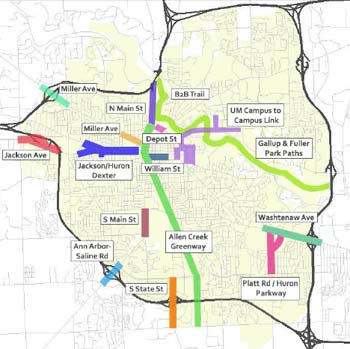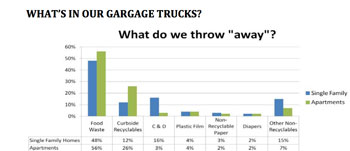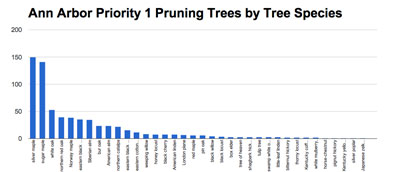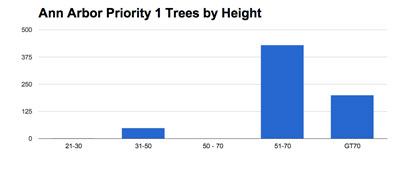Dec. 16, 2013 Ann Arbor Council: Preview
The Ann Arbor city council’s last regular meeting of the year, set for Dec. 16, 2013, features an agenda with about a dozen substantive voting items.

Screenshot of Legistar – the city of Ann Arbor’s online agenda management system. Image links to the Dec. 16 meeting agenda.
Added to the agenda on Friday before the Monday meeting is an item that relates to proceeds from the city’s sale of property known as the former Y lot. The sale of the property to Dennis Dahlmann for $5.25 million will result in a gross difference of $1.75 million compared to the $3.5 million price paid by the city in 2003.
The item added to the Dec. 16 agenda would designate $1.56 million of that amount – which is all but a $190,000 brokerage fee – for deposit in the city’s affordable housing trust fund.
That would reflect a departure from the policy set in a 2012 council resolution, which called first for reimbursement of costs out of the proceeds, including interest paid over the last 10 years, before depositing those net proceeds into the affordable housing trust fund.
Although the city administrator is not required to present next year’s FY 2015 budget to the council until April 2014, at least three items on the council’s Dec. 16 agenda could have an impact on preparation of that budget. Some of those items relate to mobility and traffic issues.
First, the council will consider directing city administrator Steve Powers to include in the FY 2015 budget an additional $10,000 in community events funding to support the Ann Arbor Street Art Fair.
Second, the council will consider directing Powers to present a plan for funding elements of the city’s non-motorized transportation plan by specific dates: by Feb. 1, 2014, the plan’s recommended midblock deployments of rectangular rapid flashing beacons (RRFB); by April 21 the near-term recommendations of the plan; and by June 30 the long-term elements of the plan.
Thematically related to the funding plan for non-motorized improvements is a third budget item: a proposal to allocate $125,000 from the current general fund reserve to pay for police overtime for traffic enforcement.
That item is sponsored by Stephen Kunselman (Ward 3), Jack Eaton (Ward 4) and Jane Lumm (Ward 2), who were part of a six-vote majority that had backed a significant revision to the city’s crosswalk law at the council’s Dec. 2, 2013 meeting. That change – which eliminated a requirement that motorists stop for pedestrians who were at the curb but not within the crosswalk – was subsequently vetoed by mayor John Hieftje. And the text of that veto is attached to the council’s meeting agenda as a communication.
Also generally related to the public right-of-way on streets is a Dec. 16 item that was postponed from the council’s Dec. 2, 2013 meeting. The item assigns a specific cost to the removal of an on-street parking space caused by a development: $45,000. The postponement stemmed from a desire to hold a public hearing on the matter before taking action.
Several of the other Dec. 16 items relate generally to the theme of the environment. In the area of solid waste management, the council will consider a roughly $65,000 allocation from the solid waste fund balance. That allocation will pay for an initiative that will allow residents to add plate scrapings to their brown compost carts for curbside collection. The additional funds will cover an increased level of service at the compost processing facility (daily versus weekly grinding). The funds will also cover the cost of counter-top containers the city plans to give away to residents to encourage the initial separation of plate scrapings from garbage, and a subsidy for the sale of additional brown compost carts. Some of that allocation is expected to be recovered through reduced landfill tipping fees.
Other solid waste items on the Dec. 16 agenda include one to allocate about $63,000 to rebuild a baler at the city’s materials recovery facility. And the council will consider an amendment to the contract with Waste Management, which provides commercial waste collection services – to factor in special event service pricing on Sundays for up to five collection containers that are otherwise serviced daily. The council will also consider authorizing the purchase of about 150 300-gallon carts per year ($42,000) for the next four years – which will be used as part of the city’s commercial and multi-family recycling program.
Also part of the environmental theme on the Dec. 16 agenda is an item that accepts a $50,000 grant from the USDA Forestry Service to be spent on a tree pruning initiative focused on the city’s largest street trees.
Additional items include two standard rezoning approvals in connection with annexations from townships into the city. The recommending body for zoning approvals is the city planning commission. Also on the Dec. 16 agenda is an item that asks the council to approve changes to the planning commission bylaws. Those bylaws changes relate to the required notice for special accommodations like a sign-language interpreter – changing the requirement from 24 hours to two business days.
This article includes a more detailed preview of many of these agenda items. More details on other agenda items are available on the city’s online Legistar system. The meeting proceedings can be followed Monday evening live on Channel 16, streamed online by Community Television Network.
Y Lot Proceeds
The history of the city’s policy on the proceeds of city-owned land and the connection to the city’s affordable housing trust fund goes back at least 20 years.
Some highlights are laid out in a timeline below.
The specific connection between the affordable housing trust fund and the former Y lot is the 100 units of single-resident occupancy housing that previously were a part of the YMCA building that stood on the site.
Various efforts have been made to replace those units over the years. [See, for example: "The 100 Units of Affordable Housing."] Recently, the Ann Arbor housing commission and its properties have started to receive more attention from the council as an integral part of the city’s approach to providing housing to the lowest income residents. The council approved a series of resolutions this last summer that will allow the AAHC to convert many of its properties to project-based vouchers.
The approved $5.25 million sale price of the former Y lot will result in a gross difference of $1.75 million compared to the $3.5 million price paid by the city in 2003. At the council’s Dec. 16, 2013 meeting, consideration will be given to a resolution that would designate $1.56 million of that amount – which is all but a $190,000 brokerage fee – for deposit in the city’s affordable housing trust fund.
This would reflect a departure from the most recent policy adopted by the city council, but would eliminate any wrangling between the city and the Ann Arbor Downtown Development Authority over how much in reimbursements might be owed for various purposes. The DDA has calculated $1,493,959 in reimbursements that it thinks it could claim – for interest payments and cost of demolition, among other items. But the DDA board has voted essentially to waive that claim. And the city has calculated, for example, that $365,651 in interest reimbursements could be owed, as well as $488,646 for the relocation of residents of the former Y building.
In timeline overview form:
- April 15, 1996: City council establishes a policy that put half of the proceeds from city-owned land sales into the affordable housing trust fund. The minutes of the meeting show that Jane Lumm (Ward 2) voted against an amendment, made at the council table, to divide the proceeds of land sales (less costs) between “infrastructure needs and the housing trust fund regardless of budget year.” But the minutes show that the vote on the amended resolution was declared unanimous on a voice vote (not a roll call). In 1996, part of the impetus for consideration of a land sale policy was driven by city-owned property at Packard and Main, which eventually became a part of the Ashley Mews development.
- Nov. 5, 1998: City council votes to increase the portion of proceeds of city-owned land sales that would be earmarked for the affordable housing trust fund – from half to all. Lumm joined her Ward 2 colleague David Kwan in voting against this policy shift.
- Dec. 8, 2003: City council approves purchase of Y property – on William Street between Fourth and Fifth avenues – for $3.5 million, financing the purchase with a five-year loan. The Ann Arbor DDA had agreed to pay some of the interest on that loan through an action taken not by its full board, but rather by its executive committee, on Dec. 5, 2003.
- Oct. 20, 2005: Pipe bursts in YMCA building, displacing residents. The building is ultimately determined to be not worth the cost of renovation.
- June 4, 2007: City council votes to rescind the policy that put the proceeds from the sale of city-owned land into the affordable housing trust fund. The policy shift in 2007 took place as part of a relatively small land transaction: The city was selling a piece of land on East Eisenhower for $23,750. The proceeds were earmarked for the construction fund of the new municipal center, built at the corner of Fifth and Huron. But in order to put the money from the sale into that construction fund, the council needed to change the existing policy on land sales. So one of the “resolved” clauses in the resolution was the following:
RESOLVED, That City Council revoke Resolution R-481-11-98 which provided that the proceeds from the sale of excess City property be deposited into the Affordable Housing Trust Fund;
In the course of deliberations, the council agreed to amend the resolution so that the $23,750 in proceeds from this particular land sale would still be deposited in the affordable housing trust fund – but left the basic policy change intact. The council had an eye toward changing the policy anyway – so that the roughly $3 million in proceeds of the sale of the First & Washington parcel (to Village Green for construction of the City Apartments project) could be put toward the new police/courts building.
- Dec. 1, 2008: City council authorizes five-year extension of the renewal on terms from the Bank of Ann Arbor to finance the Y lot loan. During deliberations, some of the focus is on the need to divest the city of the property. Sandi Smith (Ward 1), at her second meeting after winning election to the council a month earlier, put the interest payments in the context of the cost of supporting a homeless person:
In deliberations, councilmember Sandi Smith said that she would support the continued financing of the property, because they had no other choice, but that she urged her colleagues to begin thinking of master planning the area so that the city could divest itself of the property as soon as possible. [The master planning of the area was eventually realized in the form of the Connecting William Street project.] Smith noted that given the $5,000 cost of supporting a homeless person, the interest-only payments could be used to support 27 people. The math goes like this: ($3,500,000)*(.0389)/5,000.
- Sept. 19, 2011: City council approves the sale of a strip of the former Y lot for $90,000 to facilitate construction of new Blake Transit Center by the Ann Arbor Area Transportation Authority. The total parcel area of the strip was 792 square feet.
- April 26, 2012: Board of the AAATA approves the purchase of a strip of the former Y lot for $90,000 to facilitate construction of new Blake Transit Center.
- Sept. 5, 2012: DDA board passes a resolution urging the city council to dedicate proceeds of the sale of city land to support affordable housing.
- Sept. 5, 2012: Washtenaw County board of commissioners passes a resolution urging the city council to dedicate proceeds of the sale of city land to support affordable housing. [At the time, county commissioner Leah Gunn served on the DDA board, along with former county administrator Bob Guenzel, who continues to serve on the board.]
- Sept. 17, 2012: City council considers but postpones action on a policy for proceeds of the sale of city-owned land.
- Oct. 15, 2012: City council approves a policy that ultimately leaves the policy on the use of proceeds of city land to case-by-case decisions, but indicates that for the Y lot, the proceeds will:
… first be utilized to repay the various funds that expended resources on the property, including but not limited to due diligence, closing of the site and relocation and support of its previous tenants, after which any remaining proceeds be allocated and distributed to the Affordable Housing Trust Fund;”
- Nov. 8, 2012: City council transfers $90,000 from proceeds of the land sale to AAATA into the affordable housing trust fund.
- March 4, 2013: City council directs the city administrator to select a broker for the Y lot.
- July 3, 2013: City administrator Steve Powers announces that he’s selected Colliers International and local broker Jim Chaconas to handle the marketing of the property.
- Nov. 18, 2013: City council approves the sale of the former Y lot for $5.25 million to Dennis Dahlmann.
- Dec. 4, 2013: DDA board waives its claim to reimbursement from the sale of the Y lot.
Community Events Funding
At its Dec. 16 meeting, the council will consider directing city administrator Steve Powers to include in the fiscal year 2015 budget an additional $10,000 in community events funding to support the Ann Arbor Street Art Fair. The city’s FY 2015 begins on July 1, 2014.
The memo supporting the resolution notes that the AASAF has run an annual deficit for several years. An email sent to Christopher Taylor (Ward 3) and Jane Lumm (Ward 2) by Maureen Riley, executive director of the AASAF, specified those annual deficits as follows:
- 2013 – anticipated to be approximately ($8,000)
- 2012 – ($6,316)
- 2011 – ($5,769)
- 2010 – ($6,040)
- 2009 – ($33,693)
Lumm and Taylor are sponsoring the resolution. Lumm is a former AASAF board member.
The rationale for providing support for the AASAF but not the other three art fairs is based on the additional costs the AASAF has to pay to the University of Michigan, as well as the provision by AASAF of community benefits that reduce its opportunity to gain revenue – including the Demo Zone, Art Activity Zones, Street Painting Exhibition, and the Fountain Stage. The background memo also indicates that the other three art fairs have indicated written support for the $10,000 to the AASAF.
The dollar amount roughly corresponds to the allocated cost to the AASAF from the total that is charged by the city for various services to the four art fairs collectively.
At the council’s Dec. 2, 2013 meeting, Taylor had announced his intent to bring forward the resolution asking that an additional $10,000 be included in the city’s FY 2015 budget.
Traffic Enforcement
On the Dec. 16 agenda is an item that would allocate $125,000 from the general fund balance to pay for police overtime required for additional traffic enforcement. The item began conceptually as a $500,000 allocation described by Stephen Kunselman (Ward 3), who was persuaded by co-sponsors Jane Lumm (Ward 2) and Jack Eaton (Ward 4) that $125,000 would be a more reasonable amount to spend.
Data from the city’s most recent comprehensive annual financial report (CAFR), compiled with previous CAFRs, shows that traffic citations have continued for the past three years at significantly lower levels than previously:
Some insight into the question of how much time AAPD officers have available for proactive policing activities – like traffic enforcement – has been provided to councilmembers in the form of timesheet data that officers have been logging since the beginning of 2013.
In the charts below (by The Chronicle, with data from the city of Ann Arbor), green shading indicates unassigned time and time dedicated to proactive policing activities. Dedicate policing activities include: bicycle patrol, business contact, check person, citizen/motorist assist, code citation, community event, community meeting, downtown foot patrol, extra patrol (general), extra patrol (parks), felony, impound, liquor inspection, misdemeanor, parking citation, property check, recontact, traffic enforcement (general), traffic enforcement (laser), traffic enforcement (radar), traffic problem, and traffic stop.

Ann Arbor police department timesheet analysis. AAPD provided a range of time periods, to cover for the data entry training period, as officers learned the new system and became accustomed to coding their activities in a standard way. (Chart by The Chronicle with data from the city of Ann Arbor.)
In a memo to the city administrator dated Nov. 4, 2013, chief of police John Seto indicated that he’s already begun to assign additional proactive duties to officers, based on the results of the timesheet analysis:
As a result of this data, supervisors and officers have been identifying additional dedicated proactive policing activities to engage in for the remainder of 2013. Staffing modifications will also be taking place for 2014. An additional officer will be assigned to Special Services to address traffic complaints. The distribution of Patrol Officers will also be modified to increase the number of officers assigned to the swing shift, where the volume of calls for service is greater.
Council deliberations on the $125,000 overtime allocation could feature a discussion of the ability of the AAPD to conduct additional traffic enforcement activities, without drawing on overtime.
Non-Motorized Plan Funding
On the Dec. 16 agenda is a directive to the city administrator to provide a funding plan for elements of the city’s non-motorized transportation plan.

Map identifying geographic areas for improvements for pedestrians and bicyclists, as noted in the 2013 non-motorized transportation plan update.
The council approved the updated plan at its Nov. 18, 2013 meeting.
The new document is organized into three sections: (1) planning and policy updates; (2) updates to near-term recommendations; and (3) long-term recommendations.
And the Dec. 16 resolution – which is co-sponsored by Christopher Taylor (Ward 3), Chuck Warpehoski (Ward 5) Margie Teall (Ward 4) and Sabra Briere (Ward 1) – is structured in part based on those main sections.
The resolution directs city administrator Steve Powers to present a plan for funding elements of the city’s non-motorized plan by specific dates: by Feb. 1, 2014, the plan’s recommended midblock deployments of rectangular rapid flashing beacons (RRFB); by April 21 the near-term recommendations of the plan; and by June 30 the long-term elements of the plan.
Examples of planning and policy issues include design guidelines, recommendations for approaches like bike boulevards and bike share programs, and planning practices that cover education campaigns, maintenance, crosswalks and other non-motorized elements for pedestrians and bicyclists.
For example, the update recommends that the city begin developing a planning process for bike boulevards, which are described as “a low-traffic, low-speed road where bicycle interests are prioritized.”
Sections of West Washington (from Revena to First), Elmwood (from Platt to Canterbury) and Broadway (from its southern intersection with Plymouth to where it rejoins Plymouth about a mile to the northeast) are suggested for potential bike boulevards.
Near-term recommendations include lower-cost efforts like re-striping roads to install bike lanes and adding crossing islands.
Longer-term projects that were included in the 2007 plan are re-emphasized: the Allen Creek Greenway, Border-to-Border Trail, Gallup Park & Fuller Road paths, and a Briarwood-Pittsfield pedestrian bridge.
The city’s non-motorized transportation plan is part of the city’s master plan. The planning commission adopted the updated plan at its Sept. 10, 2013 meeting. [.pdf of draft 2013 non-motorized transportation plan update]
With respect to the adoption of the master plan, the council and the planning commission are on equal footing. That is, they must adopt the same plan. So in this case, the commission is not merely the recommending body.
How Much Is a Parking Space Worth?
Postponed from the council’s Dec. 2 meeting is a resolution that would define how much developers would need to pay the Ann Arbor Downtown Development Authority if a developer’s project requires removal of a metered on-street parking space. The proposed amount is $45,000 per space. The payment would go to the Ann Arbor DDA because the DDA manages the public parking system under a contract with the city.
The rationale for postponing the item – offered by Christopher Taylor (Ward 3) at the council’s Dec. 2 meeting – was that because it amounts to a fee, a public hearing should be held on the matter before the council votes.
In this matter, the council would be acting on a four-year-old recommendation approved by the Ann Arbor DDA in 2009:
Thus it is recommended that when developments lead to the removal of on-street parking meter spaces, a cost of $45,000/parking meter space (with annual CPI increases) be assessed and provided to the DDA to set aside in a special fund that will be used to construct future parking spaces or other means to meet the goals above. [.pdf of meeting minutes with complete text of March 4, 2009 DDA resolution]
The contract under which the DDA manages the public parking system for the city was revised to restructure the financial arrangement (which now pays the city 17% of the gross revenues), but also included a clause meant to prompt the city to act on the on-street space cost recommendation. From the May 2011 parking agreement:
The City shall work collaboratively with the DDA to develop and present for adoption by City Council a City policy regarding the permanent removal of on-street metered parking spaces. The purpose of this policy will be to identify whether a community benefit to the elimination of one or more metered parking spaces specific area(s) of the City exists, and the basis for such a determination. If no community benefit can be identified, it is understood and agreed by the parties that a replacement cost allocation methodology will need to be adopted concurrent with the approval of the City policy; which shall be used to make improvements to the public parking or transportation system.
Subject to administrative approval by the city, it’s the DDA that has sole authority to determine the addition or removal of meters, loading zones, or other curbside parking uses.
The $45,000 figure is based on an average construction cost to build a new parking space in a structure, either above ground or below ground – as estimated in 2009. It’s not clear what the specific impetus is to act on the issue now, other than the fact that action is simply long overdue. In 2011, the University of Michigan’s Institute for Social Research expansion was expected to result in the net removal of one on-street parking space. [For more background, see: "Column: Ann Arbor's Monroe (Street) Doctrine."]
The resolution is sponsored by Christopher Taylor (Ward 3). Taylor participated in recent meetings of a joint council and DDA board committee that negotiated a resolution to the question about how the DDA’s TIF (tax increment finance) revenue is regulated. In that context, Taylor had argued adamantly that any cap on the DDA’s TIF should be escalated by a construction industry CPI, or roughly 5%. Taylor’s reasoning was that the DDA’s mission is to undertake capital projects and therefore should have revenue that escalates in accordance with increases in the costs to undertake capital projects.
Based on Taylor’s reasoning on the TIF question, and the explicit 2009 recommendation by the DDA to increase the estimated $45,000 figure in that year by an inflationary index, the recommended amount now, four years later, would have be closer to $55,000, assuming a 5% figure for construction cost inflation.
The actual cost of building an underground space in the recently completed (2012) underground Library Lane parking structure could provide a more current estimate, but the DDA has not made public a breakdown of how that project’s actual costs lined up with its project budget. The DDA has exercised its statutory right to extend the deadline in response to a request from The Chronicle for that information under Michigan’s Freedom of Information Act
The last two month’s minutes from the DDA’s committee meetings don’t reflect any discussion of the on-street parking space replacement cost. Nor has the issue been discussed at any recent DDA board meeting.
By way of additional background, the Ann Arbor DDA’s most recent financial records show that last year, on-street parking spaces generated $2,000 in gross revenue per space or $1,347 in net income per space annually. The contract with the city under which the DDA operates the public parking system stipulates that the city receives 17% of the gross parking revenues. So the city’s revenue associated with an on-street parking space corresponds to $340 annually.
Solid Waste: Plate Scrapings
The Dec. 16 city council agenda item – to allocate $64,550 from the solid waste fund to support a food-scrap composting initiative – comes in the context of the council’s recent adoption of an update to the city’s solid waste plan. When the city council adopted the solid waste plan update on Oct. 7, 2013, a modification was made during deliberations.

An inventory of a sample of contents of Ann Arbor garbage trucks showed that about half of the weight is due to food waste. (Chart from the city’s solid waste plan update.)
The amendment undertaken by the council at that meeting eliminated mention of a possible transition to bi-weekly trash pickup or pay-as-you-throw initiatives.
However, one of the recommendations that is thought possibly to lead to a reduction in curbside garbage pickup – which would have been the basis for any decision to reduce the frequency of trash pickup – was left in the plan.
That recommendation is to allow plate scrapings to be placed in residents’ brown composting carts that the city uses to collect yard waste for processing at the city’s composting facility. That facility is operated by a third-party – WeCare Organics. The goal is to reduce the proportion of the city’s landfilled solid waste stream that’s made up of food waste. A recent inventory of the contents of some city trash trucks showed that about half of the weight is made up of food waste.
[Waste Less: City of Ann Arbor Solid Waste Resource Plan.] [Appendices to Waste Less] [Previous Chronicle coverage: Waste as Resource: Ann Arbor's Five Year Plan.]
The $64,550 allocation from the solid waste fund balance on the Dec. 16 agenda would pay for the initiative that will allow residents to add plate scrapings to their brown compost carts for curbside collection. The additional funds break down this way:
- $14,950 for an increased level of service from WeCare Organics at the compost processing facility (daily versus weekly grinding). The city is estimating no increased net cost for this increased service based on a reduction in landfill tipping fees. The city pays $25.90 per ton for transfer and disposal of landfilled waste. That’s $7.90 more than the city pays WeCare organics ($18 per ton) for processing compostable material. City staff is estimating that the program will divert 2,100 tons from the $25.90 category – for a savings of 2,100*$7.90=$16,590.
- $24,600 for the cost of 6,000 Sure-Close counter-top containers the city plans to give away to residents to encourage the initial separation of plate scrapings from garbage.
- $25,000 for a subsidy to sell an estimated 1,000 additional brown compost carts to residents at a cost of $25 per cart instead of $50 per cart. About 12,000 carts are already in use.
Tree Pruning
The council will be considering the receipt of a $50,000 grant from the USDA Forestry Service – to put toward a tree pruning initiative. The pruning program would target those trees in the public right-of-way that are most in need of pruning (Priority 1). The initiative is also focused on the larger of the city’s street streets – those bigger than 20 inches in diameter. Those are the trees that have the greatest impact on the mitigation of stormwater.
Here’s where the trees targeted by the program are located:
From the city’s online tree inventory, The Chronicle queried those trees greater than 20 inches in diameter and designated as Priority 1 for pruning. A total of 684 trees fit those criteria. Here’s how they broke down by height, diameter and species.

Priority 1 trees by species. Maples are the dominant species among those that will be targeted by this pruning program. (Chart by The Chronicle with data from the city of Ann Arbor.)
The Chronicle could not survive without regular voluntary subscriptions to support our coverage of public bodies like the Ann Arbor city council. We sit on the hard bench so that you don’t have to. Click this link for details: Subscribe to The Chronicle. And if you’re already supporting us, please encourage your friends, neighbors and colleagues to help support The Chronicle, too!









